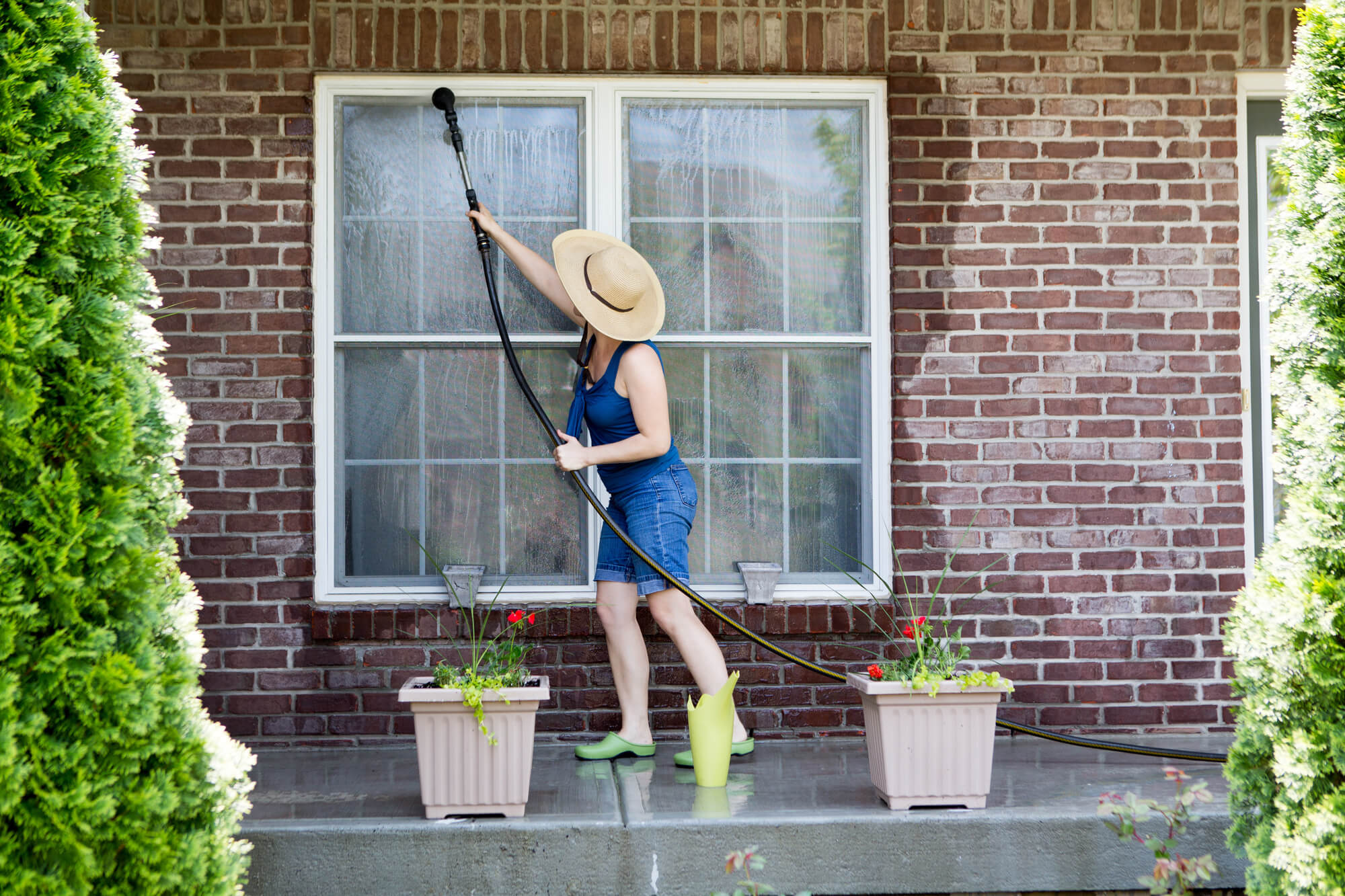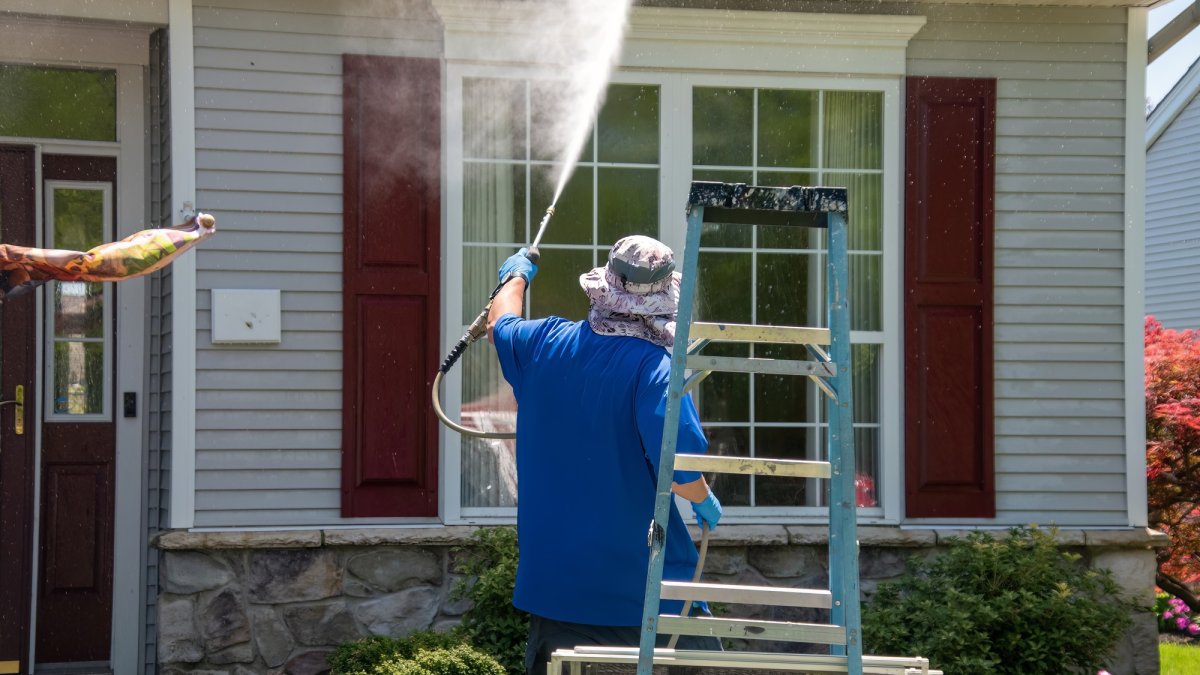
When it comes to maintaining the exterior of your home, two popular methods stand out: pressure washing and soft washing. Both techniques are effective for cleaning various surfaces, but they have different purposes and distinct advantages and drawbacks. Choosing the right method depends on the type of surface to be cleaned, the level of dirt or grime present, and the sensitivity of the material to high pressure.
Read on to learn which is the right cleaning method for your home: pressure washing or soft washing.
Understanding Pressure Washing

Pressure washing, or power washing, utilizes high-pressure water spray to remove substances like dirt, dust, loose paint, mold, grime, and mud from surfaces and objects such as buildings, concrete, and vehicles. The force generated by a pressure washer can vary significantly, making it a versatile tool for heavy-duty cleaning tasks. Given pressure washing’s complexities, hiring professionals is often prudent. They ensure compliance with environmental regulations to protect local waterways and resources.
Therefore, if you’re living in a location with specific cleaning challenges, such as the humid and vibrant environment of New Orleans, finding a reliable service provider specializing in pressure washing New Orleans can be an excellent idea. They offer a blend of expertise tailored to the unique demands of local homes.
Pros Of Pressure Washing
Pressure washing is a powerful cleaning technique that utilizes high-pressure water spray to tackle various outdoor cleaning tasks. Below are some benefits:
- Effectiveness: This method efficiently removes tough stains, mold, and grime from hard surfaces like concrete, brick, and stone.
- Time-saving: The ability of pressure washing to quickly clean large areas reduces the time and effort needed for manual scrubbing, ideal for busy individuals.
- Versatility: Adjustable settings make it suitable for various tasks, from removing old paint to cleaning sidewalks, showcasing its wide applicability.
This method provides an effective, efficient, and flexible way to maintain outdoor spaces’ cleanliness and aesthetic appeal, making it an indispensable tool for homeowners and maintenance professionals.
Cons Of Pressure Washing
Despite the effectiveness of pressure washing in cleaning various surfaces, it’s important to consider its potential drawbacks. The cons of using this method include:
- Damage Risk: The intense force from pressure washing can harm softer materials like wood and siding, requiring careful management to prevent damage.
- High Water Usage: Known for consuming a lot of water, this method raises concerns in areas with water conservation measures or scarcity.
- Environmental Risks: Runoff from pressure washing can pollute storm drains, harming aquatic ecosystems and water quality.
These factors highlight the need for cautious and informed use of pressure washing, especially when dealing with vulnerable surfaces or in environmentally sensitive areas.
Exploring Soft Washing
Soft washing is a gentler cleaning method that uses low-pressure water combined with special cleaning solutions to remove dirt, bacteria, algae, and other organic stains from surfaces. This method is particularly suitable for materials that could be damaged by high pressure.
Pros Of Soft Washing
Soft washing emerges as a considerate cleaning method, especially suited for the delicate exteriors of homes and buildings. The following are some pros to remember:
- Gentle on Surfaces: It employs a low-pressure spray, making it the method of choice for fragile materials such as roof shingles, wood paneling, and soft stone, ensuring they remain undamaged.
- Long-Lasting Results: This approach targets and eradicates the root causes of mold, algae, and mildew, securing a cleanliness that endures longer than that achieved by high-pressure alternatives.
- Eco-Friendly Options: Using biodegradable cleaning agents in soft washing not only effectively cleans but also respects the surrounding environment, reducing the potential for harm to nearby plant life and wildlife.
Soft washing stands out for its ability to combine efficacy with care, offering a sustainable option for maintaining the pristine condition of a property’s more sensitive features.
Cons Of Soft Washing
While soft washing is celebrated for its gentle touch on delicate surfaces, it’s essential to acknowledge its limitations and potential drawbacks. These may include:
- Chemical Use: The reliance on specialized cleaning solutions raises concerns about the potential harm to surrounding flora and fauna, necessitating cautious management to avoid environmental damage.
- Limited Application: This method may fall short against stubborn, non-organic stains and deep-seated dirt, sometimes requiring alternative cleaning strategies for a thorough restoration.
Understanding these considerations ensures a balanced approach to maintaining property aesthetics and integrity.
Choosing The Right Method For Your Home
The decision between pressure washing and soft washing largely depends on the surface material and the type of dirt or growth present. For instance, hard surfaces like concrete driveways, brick walkways, and stone patios are ideal candidates for pressure washing. The robust nature of these materials means they can withstand the force of high-pressure water without sustaining damage.
On the other hand, delicate surfaces like roof shingles, wood siding, and soft stone should be cleaned with the soft washing method. The gentle approach ensures that these sensitive materials aren’t eroded or damaged during cleaning.
Conclusion
Pressure and soft washing have their place in home maintenance, each offering distinct benefits for different situations. By understanding the strengths and limitations of each method, you can make informed decisions that preserve the beauty and integrity of your homes while considering environmental sustainability.
Brendon Mitchell
Related posts
Stay connected
- How LoveOn Chat Is Becoming the Most Versatile AI Companion for Digital UsersThe internet keeps shifting toward hyper-personal interaction, and AI companions are at the center of this shift. What used to be simple chatbots are now evolving into emotionally aware, adaptive, and multi-functional digital partners. Among the new generation of platforms, LoveOn Chat is becoming one... The post How LoveOn Chat Is Becoming the Most Versatile […]

